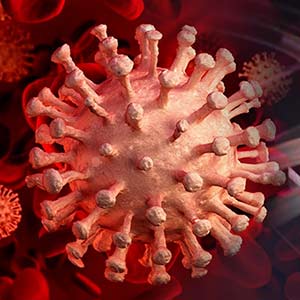The field of computational toxicology takes the spotlight in a special issue of the journal Chemical Research in Toxicology, published Feb. 15. The issue was co-edited by Nicole Kleinstreuer, Ph.D., acting director of the National Toxicology Program (NTP) Interagency Center for the Evaluation of Alternative Toxicological Methods(https://ntp.niehs.nih.gov/pubhealth/evalatm/) (NICEATM).
 Kleinstreuer leads computational toxicology work at NICEATM and studies the susceptibility of biological systems to disturbances that result in adverse health outcomes. (Photo courtesy of Steve McCaw / NIEHS)
Kleinstreuer leads computational toxicology work at NICEATM and studies the susceptibility of biological systems to disturbances that result in adverse health outcomes. (Photo courtesy of Steve McCaw / NIEHS)“Computational toxicology tools support integrative approaches to toxicological research and chemical safety assessments,” explained Kleinstreuer, who holds a secondary appointment in the NIEHS Biostatistics and Computational Biology Branch.
The special issue includes 37 articles from leading researchers worldwide. Two studies are co-authored by Kleinstreuer and colleagues at NICEATM, which aims to develop and evaluate alternatives to animal use for chemical safety testing. A third describes research from elsewhere in the NIEHS Division of NTP (DNTP).
“This comprehensive collection of outstanding articles represents a rich resource for the computational toxicology field, highlighting novel methods, tools, datasets, and applications,” Kleinstreuer said. “We received a tremendous number of exceptional submissions, and although we were not able to include every article for publication, we are grateful to the scientific community for their diverse, high-quality contributions. Selecting this collection was an enjoyable challenge.”
Building better models
One paper introduces an informatics tool called Saagar — a set of structural features of molecules. Predictive models of toxicity based on molecular structures provide a valuable alternative to costly and inefficient animal testing. But there is a major drawback, said co-author Scott Auerbach, Ph.D., a DNTP molecular toxicologist.
“Predictive models built with complex, abstract descriptions of molecular structures are hard to interpret, earning them the notoriety of being black boxes,” he explained. “This lack of interpretability has discouraged investigators and regulatory decision-makers from using predictive models.”
 Hsieh works on developing human disease prediction models based on quantitative high throughput screening data from Tox21 and chemical structures. (Photo courtesy of Steve McCaw / NIEHS)
Hsieh works on developing human disease prediction models based on quantitative high throughput screening data from Tox21 and chemical structures. (Photo courtesy of Steve McCaw / NIEHS)Saagar could be a big step toward overcoming this hurdle. “Saagar features are a better choice for constructing interpretable predictive models, so hopefully they will gain wider acceptance,” he said.
The power of combining models
Auerbach was co-author and a study with lead author Jui-Hua Hsieh, Ph.D., a bioinformatician in his group, and others. The team combined an array of approaches to learn more about toxicity of a class of chemicals called polycyclic aromatic compounds (PAC). The carcinogenicity of these chemicals is well documented, but Hsieh and her team wanted to better understand if subsets of these chemicals have unique toxicological properties that may be a public health concern.
“The dual challenges are the incredible structural diversity and the wide array of biological activities displayed within the class,” wrote the authors. So, they developed a new approach, combining results of computer, cell-based, and animal studies. The scientists suggested that their strategy can be extended to other chemical classes.
Assessing cardiovascular risk
Another study co-authored by Kleinstreuer used high-throughput screening (see sidebar) to characterize potentially harmful cardiovascular effects of chemicals. DNTP Scientific Director Brian Berridge, D.V.M., Ph.D., and Shagun Krishna, Ph.D., a postdoctoral fellow in NICEATM, were co-authors.
“Cardiovascular disease is one of the most prevalent public health concerns, and mounting evidence suggests that toxic environmental chemicals could contribute to disease burden,” Kleinstreuer said.
 Krishna’s paper was selected as an NIEHS paper of the month in February. (Photo courtesy of Steve McCaw / NIEHS)
Krishna’s paper was selected as an NIEHS paper of the month in February. (Photo courtesy of Steve McCaw / NIEHS)Determining cardiovascular effects has been challenging. “It is a complex problem due in part to the abundance of untested substances; the influence of chronic, low-dose exposures and mixed exposures; and varying levels of genetic susceptibility,” she explained.
The team screened 1,138 chemicals for further evaluation based on cardiovascular toxicity scores that they derived from 314 high-throughput screening assays. This process identified several classes of chemicals of potential cardiovascular concern. These include organotins, bisphenol-like chemicals, pesticides, quaternary ammonium compounds, and polycyclic aromatic hydrocarbons.
“This approach can assist in prioritizing and identifying compounds for additional testing as part of a translational toxicology pipeline to support more targeted decision-making, risk assessments, and monitoring steps,” Berridge said.
Citations:
Hsieh JH, Sedykh A, Mutlu E, Germolec DR, Auerbach SS, Rider CV. 2021. Harnessing in silico, in vitro, and in vivo data to understand the toxicity landscape of polycyclic aromatic compounds (PACs). Chem Res Toxicol 34(2):268–285. (Summary)
Kleinstreuer NC, Tetko IV, Tong W. 2021. Introduction to Special Issue: Computational Toxicology. Chem Res Toxicol 34(2):171–175.
Krishna S, Berridge B, Kleinstreuer N. 2021. High-throughput screening to identify chemical cardiotoxic potential. Chem Res Toxicol 34(2):566¬–583.
Sedykh AY, Shah RR, Kleinstreuer NC, Auerbach SS, Gombar VK. 2021. Saagar-A new, extensible set of molecular substructures for QSAR/QSPR and read-across predictions. Chem Res Toxicol 34(2):634–640.











